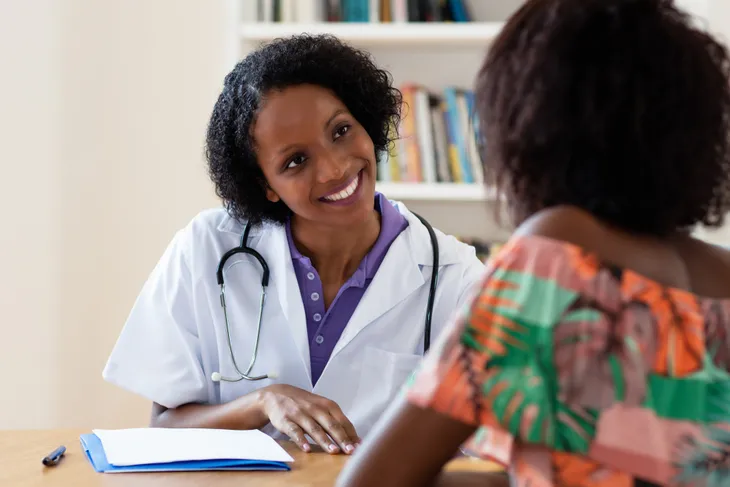- Fluoroscopy is a type of X-ray, often used to diagnose internal blockages or narrowing of passages in arteries.
- Unlike a single X-ray, this type uses a series of X-rays to show movement in the interior of the body over time.
- Fasting from foods and liquids is vital prior to fluoroscopy.
Fluoroscopy is a medical procedure that can be used to diagnose a variety of internal symptoms. This series of X-rays use illumination and moving pictures to see how the body’s internal systems operate. It can be used to analyze parts of the cardiovascular, skeletal, digestive, urinary, respiratory, or reproductive systems. It’s primarily used as a diagnostic tool, working in part with tests such as barium X-rays, cardiac catheterization, and lumbar punctures to give radiologists and other medical professionals a better idea of what may be causing a patient’s symptoms. Fluoroscopy is used to help diagnose a broad range of conditions, including hiatal hernias and ulcerative colitis. Preparing for any medical test can be unsettling, but understanding what to expect can help ease some of that anxiety.
Preparing for Adverse Reactions and Allergies
Fluoroscopy is generally considered a safe procedure; however, that doesn’t mean it’s completely without risk. Those who’ve been exposed to high levels of radiation in the past, either through excessive radiology examinations or otherwise, may face a higher risk of adverse reactions after fluoroscopy.
Additionally, if the test requires the injection of contrast dye, patients could be at risk for an unexpected allergic reaction. To be safe, it’s best to inform the radiologist of any allergies or sensitivities to medications, iodine or other substances.
Understanding Potential Risks
In some types of fluoroscopy, patients may experience side effects in the hours or days following the test. For example, fluoroscopy tests that look at the digestive system often require the patient to swallow barium, a chalky drink that illuminates the digestive tract. In some cases, barium can result in difficulties analyzing organs in the abdomen or lower back.
Additionally, there are increased risks to those who are pregnant, as well as those with kidney problems. It’s important for patients to discuss their health history with their physician or radiologist prior to their fluoroscopy.
Fasting May Be Required
Some fluoroscopy examinations require the patient to have an empty stomach. Prior to the test, a doctor or medical assistant will provide directions, which may include abstaining from eating and drinking prior to the test.
In most cases, fasting before fluoroscopy simply begins at midnight the night before the procedure is scheduled and includes avoiding all food, clear fluids, water and medications until after the exam is complete. When fasting instructions are given, it’s crucial to follow them to ensure the test can be conducted effectively.
Provide a List of Medications
It’s important for the radiologist to know what medications the patient is taking. Before heading to the clinic, patients should take the time to write a comprehensive list of any medications they’re taking, as well as the dosage and frequency with which they take them.
The list should include all current prescriptions, prescriptions that have recently been stopped, and over-the-counter medications, herbs, and vitamins that are taken regularly. This list is important because some medications can interact with fluoroscopy dyes or affect the outcome of the test.
Talk to the Radiologist About Any Allergies
Whether they seem relevant or not, any allergy can affect a fluoroscopy examination. This is especially true if contrast dye is going to be used in the procedure.
Before the test, patients should be prepared with a list of allergic reactions they’ve had in the past, regardless of the allergen or severity of the reaction. The radiologist, technologist, or medical assistant will be able to determine the importance of each allergy and whether the test will be affected by it.
 Shutterstock/fizkes
Shutterstock/fizkesKnow Your Health History
Just as with medications and allergies, health history is an important part of determining how well fluoroscopy will work as a diagnostic tool. It can also play a role in determining the risks of this procedure.
Before attending the appointment, patients should be prepared to share information about past procedures and diagnostic tests, as well as any health conditions they experience. Furthermore, females should inform the radiologist if they’re pregnant, trying to conceive, or breastfeeding.
Asking Questions
Patients often have questions about procedures and tests they’ll undergo, and it’s important to ask them before giving consent. Patients should take time to prepare a list of questions before heading to the appointment. Some common questions to ask include:
- How long does the procedure take?
- What should I expect during the exam?
- What happens if I feel anxiety, pain, or discomfort during the procedure?
- When can I expect results?
- What are some possible outcomes I should be prepared for?
Giving Consent
Before the fluoroscopy starts, a medical assistant or technologist may ask for written consent. Typically, patients will be provided with a form that explains the procedure, its risks, and any side effects that may be experienced in the hours or days following.
Patients should read this form carefully and make sure they understand what to expect. This is also a good opportunity to ask any further questions that arise and discuss concerns with the technologist or radiologist.
Be Prepared to Undress
In most cases, patients are asked to undress fully prior to undergoing fluoroscopy. Upon arriving at the appointment, a nurse or medical assistant will typically provide them with a gown to wear and ask that they undress.
Tests that aren’t performed on the reproductive system may allow the patient to keep underwear on beneath their gown. Prior to attending the appointment, it’s also best to remove any jewelry or accessories and leave them at home.
What to Expect During Fluoroscopy
The procedure differs for everyone due to the wide range of applications fluoroscopy has in the medical field. In some cases, this procedure can be used to help in orthopedic surgeries, such as those that are needed to repair fractured bones. In others, fluoroscopy requires the insertion of a catheter into the urinary tract or into an artery.
Those who need the procedure to diagnose digestive tract problems are more likely to require barium before or during their procedure. The good news is that in most fluoroscopy procedures, patients experience little to no discomfort, and side effects are minimal.
The Use of Anesthesia
In most cases, anesthesia is not required prior to fluoroscopy. Most often, a general anesthetic, which is a medicine that numbs only the nerves in the region requiring the test, is enough to prevent pain or discomfort. However, when fluoroscopy is used to aid surgical procedures, general anesthesia — that is, medicine that puts the patient to sleep during the procedure — may be required.
Some fluoroscopic procedures, including barium swallow examinations, don’t require any anesthetic at all. Ask your doctor or technologist what to expect ahead of time, especially if you’re quite anxious about the procedure.
Receiving and Interpreting Test Results
After a fluoroscopic procedure, the radiologist will likely interpret the test and send results to the physician who ordered the test and the patient’s family doctor, assuming that’s a different person. Obtaining test results can take as little as a few days or as long as several weeks. The wait time will ultimately depend on the reason the procedure was ordered, how complicated the test is to interpret and any backlog the office is experiencing.
Once the ordering physician has received results, it’s their responsibility to contact the patient to discuss further treatment or follow-up requirements.
 novak.elcic / Shutterstock
novak.elcic / Shutterstock












